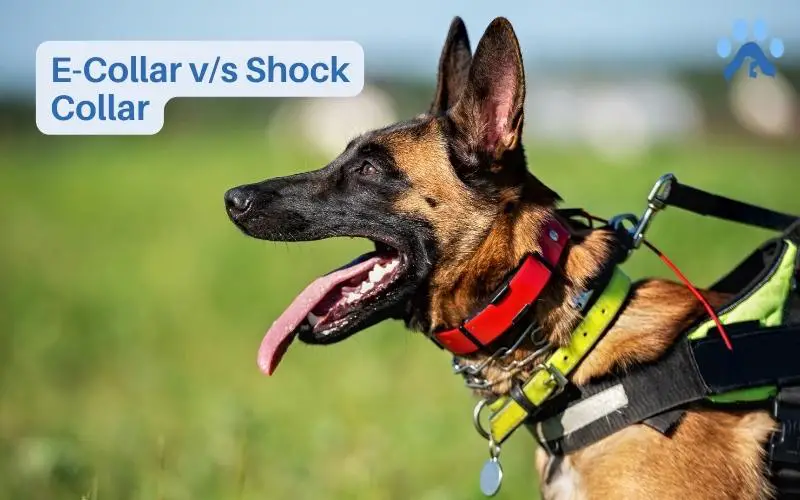E-collar vs. shock collar is a debate that has been heating up in recent years. While the terms are often used interchangeably, they refer to the same types of dog collars. That means there is no particular difference between shock collar vs. e-collar.
Then why do people use the same terms for a single training device? Essentially, the shock term was traditionally used to deter general pet owners from consuming this product. In contrast, people who were familiar with the e-collar training method used to address these devices as e-collars.
Since an e-collar or electronic collar and shock collar both deliver static electronic stimulation to your dog, they’re used primarily for the same purpose: to train your dog. There are, however, some key facts about these electronic training collars that every pet owner should know. So, we’ll cover it shortly.
E-Collar VS Shock Collar: Truth Revealed
E-collars vs. shock collars: a history of controversy. A lot of people believe that the shock collar is there to punish dogs. It’s an entirely different training tool than the e-collar. That’s not true. Through electronic stimulation, trainers now use the shock collar to guide and influence your pet’s undesirable behaviors.
Back in the 1970s, when e-collars were first introduced, they were not really equipped with advanced technology and function to provide only an electronic shock for behavior modifications in dogs. Therefore, no one other than the professional trainers was allowed to operate these remote training collars on their pets.
However, today’s modern e-collars are a lot more advanced than the traditional ones. It is designed with one function: to deliver positive reinforcement. With their ability to provide vibration, skin receptors, and sensory receptors, the new technology offers your pet a positive reinforcement training session.
By sending a small current of electricity through the collar, the dog feels an irritation or disturbance. This irritation is not comparable to an electrical shock or burn, but it is enough to distract your dog from whatever behavior you wish to curb.
As a result, it eases the process for your pet to understand what he is doing wrong and abide by the basic obedience commands you want him to follow.
Pros and Cons
A lot of people have a negative perception of e-collar training tools because they think they’re only used to harm pets. But if used correctly, e-collars are highly beneficial for training animals. As e-collars and shock collars are interchangeably the same things, there are both pros and cons of e-collar that a professional dog trainer suggests,
- An e-collar is a valuable tool in stopping aggressive and dangerous behaviors in dogs.
- E-collars prevent your dog from biting, lunging, or acting aggressively towards other pets, people, or dogs.
- It is a great way to stop bad behavior in a dog when all other training methods have failed.
- It establishes a good relationship between you and your pet throughout the positive reinforcement training.
- It will help your pet understand their negative behaviors by themselves after a few training sessions.
- On the contrary, if you are not an expert trainer, using a shock collar might cause physical damage to your pup.
- These training tools can also inflict negative reinforcement on your pets if you do not offer them treats and use the tool as a punishment.
Static Correction and Static Shock Dog Collars
When using an e-collar on your dog, it’s essential to understand how the collar works and how it should be used. “Static correction” is just a description of the type of electrical pulse that emits from the collar.
Continuous stimulation is a more accurate description of the e-collar process. With this sort of collar, you simply press a button to emit a pulse that causes your dog to move away from what he was doing.
Many pets are uncomfortable with the sensation of static collars. After all, not all static shock collars can be ideal for all dogs. Dogs might react differently to different intensity levels and different kinds of shocks. It’s essential to first establish a list of your dog’s bad habits and then choose a collar based on its recommended intensity level.
Fine-tuning static correction is made easy with modern shock collars that come with multiple levels of static correction. The range can vary from 50 to 100 pulses, or even more for the most advanced models.
It’s also important to remember that electric shocks should be enough to deter pets from doing bad things rather than inflict any kind of pain or harm. So experienced pet owners should adjust the collar themselves.
The Bottom Line
So, the debate of e-collar vs. shock collar should end here. It’s more of a terminology debate than an actual discussion. E-collars are the shock collars that do the shocking. The terms are often used interchangeably by people who don’t know any better.
This article has tried to explain why no differences exist between these two terms and what a shock or electronic collar is. We hope that this has cleared up any misconceptions about them and how they operate.
Dog collars can be a great addition to your dog’s behavior training, as they can help you correct your dog’s mistakes. However, it’s essential to start with a lower shock level and gradually work your way up. Only do this if your dogs are highly resistive to a verbal command.
FAQs
What is shock collar?
A shock collar, also known as an electronic training collar (E-collar), is a training device used on dogs. It applies electrical stimulation to the neck of the animal via a radio-controlled device in order to train it.
Are there different types of shock collars?
Shock collars can be purchased in three different types. The first type administers a shock to your dog when they cross the boundary you’ve set. The second type will administer a shock at the push of a button. The third type delivers an electric shock to your pet when they bark.
Do vets recommend shock collars?
Shock collars for dogs are recommended only when they are too aversive to obey commands. That’s what a professional veterinarian suggests. This is usually because these types of dogs are too challenging to train with any discipline other than shock.



